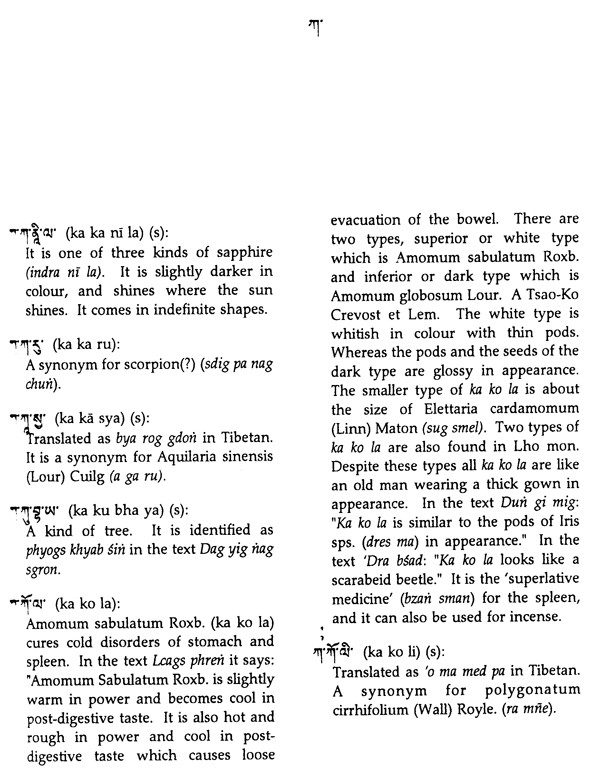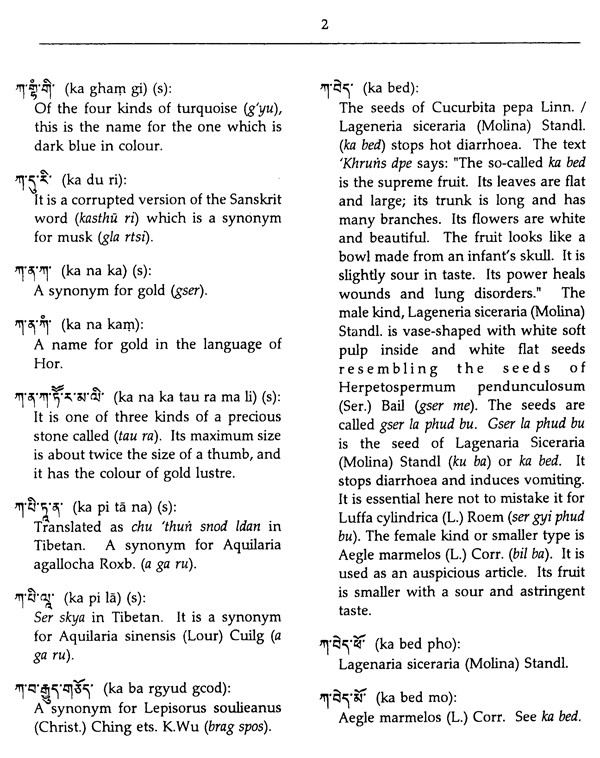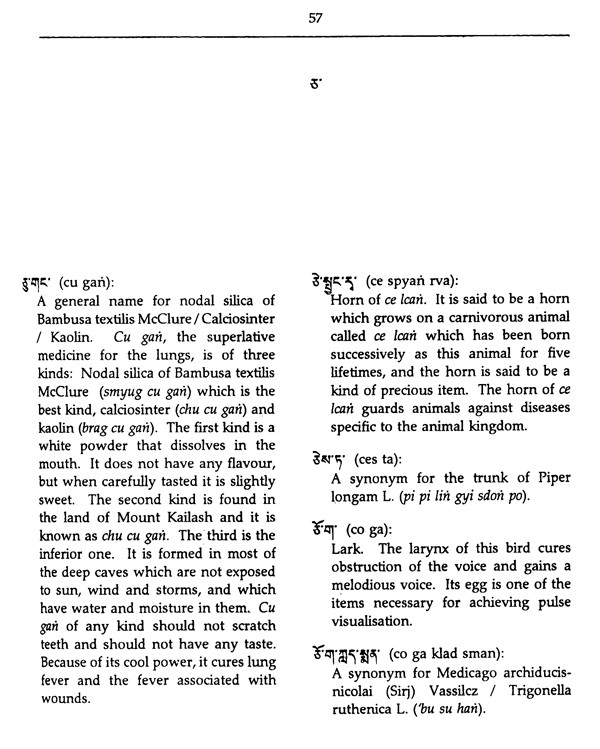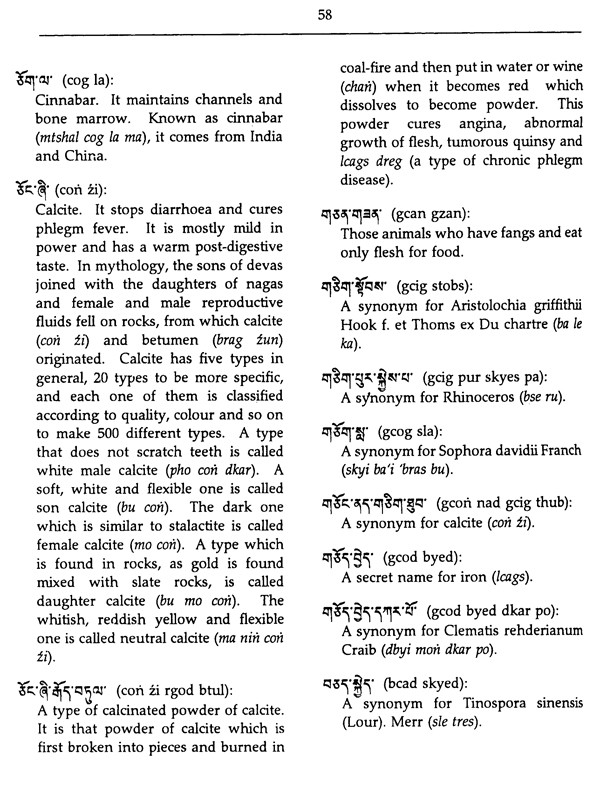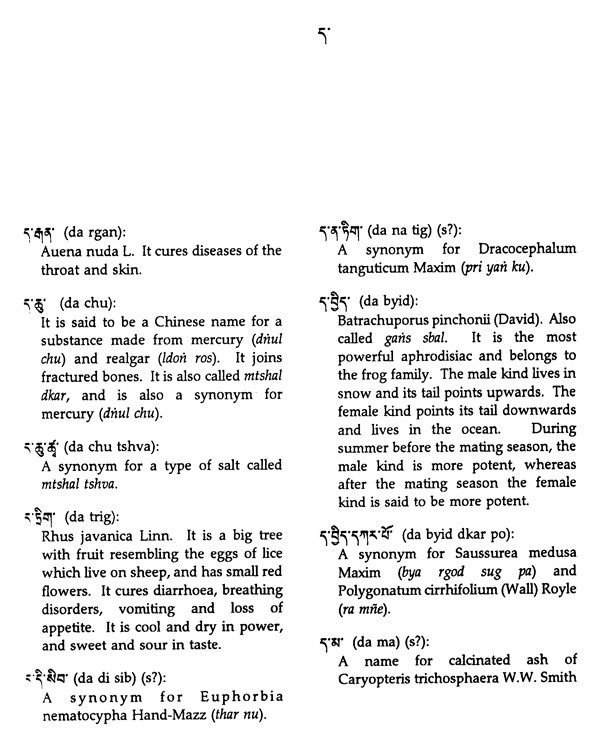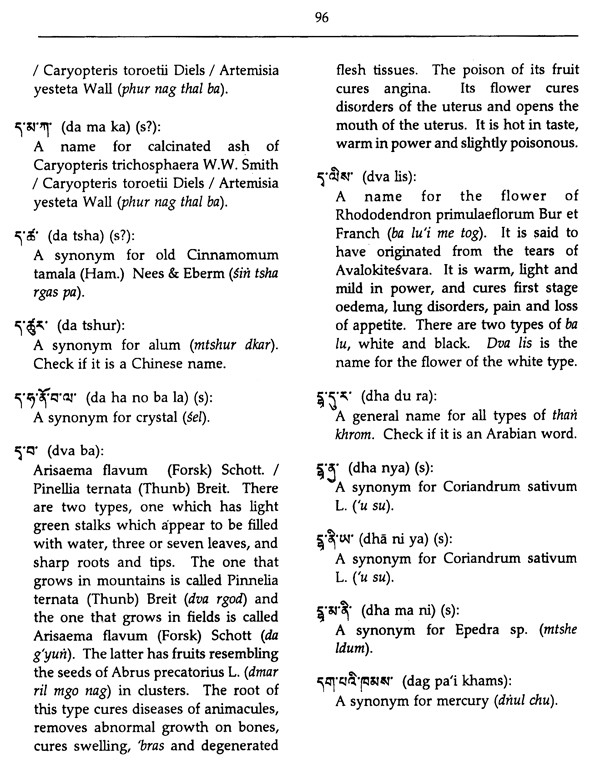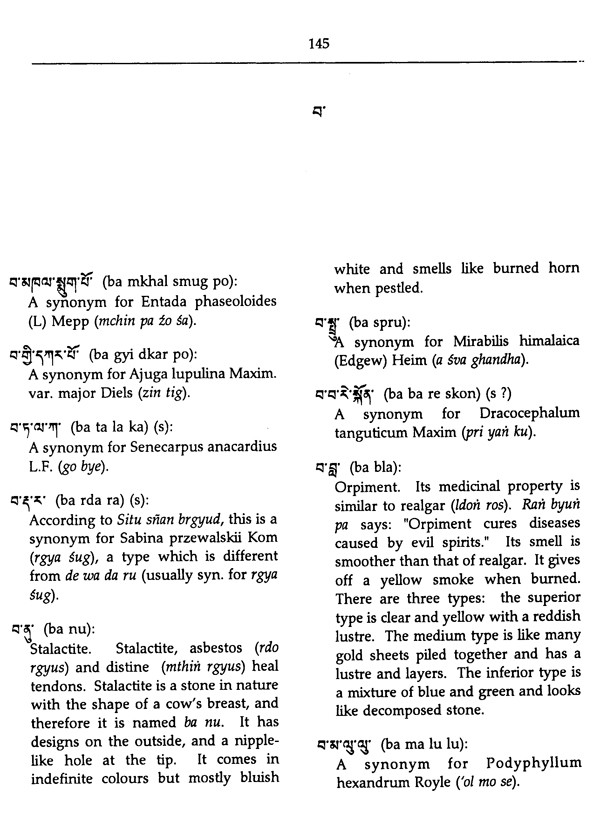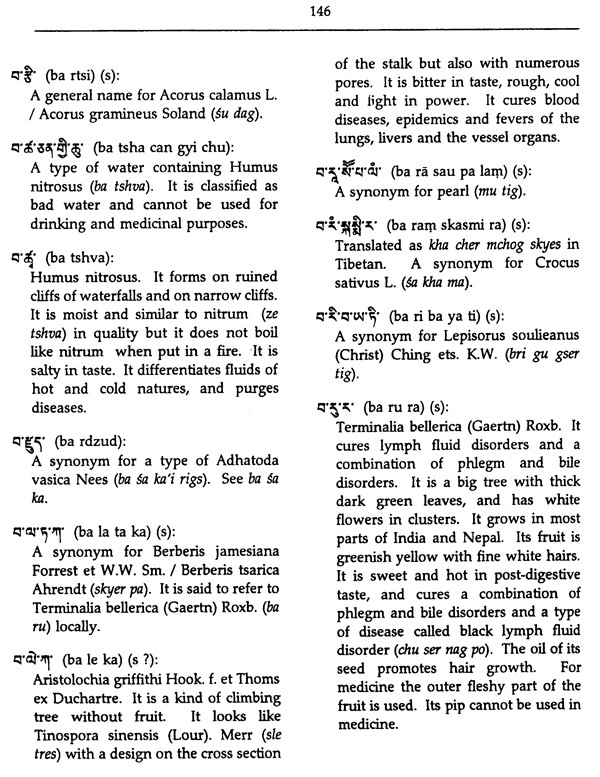
Dictionary of Tibetan Materia Medica (Rare Book)
Book Specification
| Item Code: | IDD407 |
| Author: | Dr. Pasang Yoten Arya |
| Publisher: | MOTILAL BANARSIDASS PUBLISHERS PVT. LTD. |
| Language: | English |
| Edition: | 1998 |
| ISBN: | 9788120815674 |
| Pages: | 325 |
| Cover: | HardCover |
| Other Details | 10" X 7.75" |
| Weight | 850 gm |
Book Description
Dictionary of Tibetan Materia Medica is the first dictionary of its kind. All the entries are arranged in Tibetan alphabetical order which will enable the readers to find the names of medicinal ingredients easily.
Inclusion in the main entry, of different names of medicinal ingredients such as names derived from foreign languages, synonym, secret and poetical names will prove extremely useful for identification. Description of every medicinal ingredient and information on their tastes, powers and uses are also given according to some of the most popular texts.
This dictionary was first published in Tibetan in 1994. In this English version the translator and editor, Dr. Yonten Gyatso, has given Latin names of almost all the medicines. Moreover, this English edition is a much improved and enlarged version over its Tibetan one. It has over 3,000 main entries.
Most of the materials are compiled from Sel gori sel phren, the most famous text on Tibetan Pharmacopoeia, and from Rin chen khruns dpe, one of the oldest and most reliable texts. Therefore, for the non-Tibetan readers this dictionary presents materials from the above texts which are translated for the first time into English.
This dictionary, with its many special features, will be of immense use and value for students, research scholars, doctors and pharmacologists of Tibetan medicine, and for ethno-botanists.
About the Author:
Dr. Pasang Yonten Arya graduated from Tibetan Medical and Astrological Institute (TMAI), Dharamsala, in 1977. He served in TMAI as assistant pharmacologist, and in 1982 he was appointed as the principal of the Tibetan Medical College, Dharamsala. In 1989 he worked as a lecturer in Tibetan medicine at the Central Institute of Buddhist Philosophy in Ladakh. From 1990 he began his travels to Soviet Union, Mongolia, England, Canada and Europe. He has been staying in Italy since 1992 where he founded a study group for Tibetan medicine and Yuthok Institute of Tibetan Medicine. He has written many articles and books on Tibetan medicine and astrology in Tibetan, English and Italian.
Dr. Yonten Gyatso graduated from the Tibetan Medical and Astrological Institute, Dharamsala, in 1987. He served for five years in the Plant Research Section of the Institute Research Department. He developed a modern herbarium of Tibetan medicinal plants for the Institute, for which he did extensive field research in various regions of the Himalayas with most of the famous Tibetan doctors in exile. Presently he is an independent researcher based in Dharamsala, India.
Tibetan medicine came to the notice of the outside world relatively recently, compared t0 other major traditional medicines. However, it is rapidly becoming popular as a result of numerous cases of successful treatment by Tibetan doctors, and a global trend in search of alternative cures for diseases. Many scholars and western doctors see Tibetan medicine as a profound system with a great potential to contribute to medical science. Therefore, Tibetan medicine attracts the curiosity and interest not only of patients but also of medical professionals and scientists. To keep the growing interest alive, it is necessary to supply information in the form of academic research materials. Dr. Pasang Yonten Arya’s compilation of this dictionary is such an endeavour.
To present this work to a larger audience and to broaden its scope, it is necessary to translate it into the major languages of the world. On the request of the author, I have translated this dictionary from Tibetan into English. The translation of Tibetan medical works is not an easy task, mainly because Tibetan medical translation has not yet been sufficiently developed, especially in the context of modern western medicine. There is still a need for comparative study to standardize terminologies. A brief survey of Tibetan medical literature in English is enough to testify to this.
Therefore, it has been a challenge and learning experience for me to try to translate this dictionary. I have taken great care in translating the technical terms, especially the names of the medicines and diseases which form the majority of the technical terms. In rendering these terms I have had recourse to some of the reputed English translations.
In translating the names of the medicines, I have used ‘Khruns dpe dri med sel gyi me lon’ as the main reference. This is a recent publication from Tibet. It is an extremely useful reference since it provides, for the first time, the Latin names of almost all the medicines and their sub—types recorded in the famous Tibetan pharmacopea, Dri med sel gon sel phren. I found a number of erroneous spellings of Latin names, and corrected them with the help of other references. Whenever possible, the Latin names are updated with the help of the Companion to Chopra’s Glossory of Indian Medicinal Plants.
In Tibetan medicine many of the plants, minerals, etc., have more than one common Tibetan name. For such cases I have given the Latin name of the type commonly used in practice under the given Tibetan name. For example, tig ta is of three main types: Swertia chirayita Buch Ham (rgya tig), Swertia ciliata (D.Don ex G.Don) B.L. Burtti (bal tig), and Saxifraga umbellulata Hook, F. et Thoms (bod tig). Of these three, the first is considered the most potent and therefore generally used as tig ta, which is actually a common name for all the three types. Therefore, I have given the Latin name Swertia chirayita Buch-Ham, unless specified, for the general name tig ta.
However, I have also tried to give the Latin names of all the types under one common Tibetan name whenever the number of types does not exceed three. For example, the Latin names, Oxytropis reniformis PC Li (black stag sa) and Oxytropis microphylla (pall) D.C. (white stag sa) are given the common name stag sa. In such cases the two Latin names are separated by an oblique sign.
In translating the nosological terms, Tibetan Medical Paintings and The Quintessence Tantras of Tibetan Medicine} were used as the main references. Due to a lack of satisfactory English equivalents, names of some of the diseases such as ’bras are left untranslated and their Tibetan names are given in transliterated form.
Regarding the Tibetan version of this dictionary, I found a number of spelling errors in the names of medicines and have corrected them by consulting two different editions of Sel gon sel phre1i5. A few entries in the Tibetan version of this dictionary have been deleted because they are names of medicinal formularies and therefore irrelevant. There are many names and synonyms which are mentioned as sub—entries or as cross- references in the Tibetan edition. All such entries are incorporated into the main entry, thereby enlarging this edition by 2.45 entries.
The arrangement of entries is according to Tibetan alphabetical order, but varies somewhat from the Tibetan edition as a result of the spelling correction of a • number of entries, enlargement over the Tibetan edition, and some problems with the ordering of entries which exist in the Tibetan edition.
Each entry is followed by its transliteration in English. All the Tibetan names of medicine, places, texts, people, etc. are transliterated and presented in italic form. However, the transliteration of the main entries and the place names are not italicised. For transliteration the Library of Congress system is followed. As the Sanskrit words in the text are Tibetanised and transliterated directly from the Tibetan, they are treated as Tibetan words. Thus, they have been transliterated in the same way as the Tibetan. However, words with two or more syllables combined with no separating dot (tsheg)—as is often a case with Tibetanised Sanskrit words—are transliterated without a space between the syllables. The names of people, places, and texts are transliterated with the first letter as a capital.
l would like to extend my sincere thanks to the following people who helped me in accomplishing this project: Ms. Vyvyan Cayley and Mrs. Ruth Sonam for their kind help with the English of the greater part of the text, in spite of their extremely busy schedules; to Mr. Tashi Tsering, for stimulating my interest in research in Tibetan medicine, and for his constant help and encouragement; to all the translators, scholars and doctors who have written on Tibetan medicine in English, because of whom there is already some kind of Tibetan—English dictionary of Tibetan medical terms. Last but not least, l would like to express my appreciation for the hard work of Mr. Tashi Tobgyal Phunrab of the Tibetan Computer Resource Centre, Dharamsala. I would also like to thank Mr. Jigme Tsering and his colleagues for the final typesetting of this book.
Dr. Pasang Yonten Arya was born in Dolpo, a small village in the Kyidrong area of Tibet, in 1955; he is a descendent of Khulungpa Yonten Gyatso, the tantric master of Milarepa. He escaped t0 Nepal in 1966, during the cultural Revolution in Tibet, and began his formal education in 1968 under the guidance of Ven. Geshe Gowo Lobsang Tenzin in the Shabru Bensi Primary School in Nepal. He joined the Tibetan Medical Institute of H.H. the Dalai Lama in Dharamsala in 1973 and graduated in 1977 with a distinction in 'Tibetan Medicine and Astrology, under the tuition of Professor,Bharshi Phuntsok Wangyal (1914-1983). From Dr. Jamyang Tashi Tsona (1918-1986), personal physician to H.H. the Dalai Lama, and Lady Dr. Lobsang Dolma he received teachings on traditional Tibetan pharmacology, alchemy, pulsology and diagnostic practices.
He served as assistant pharmacologist in the same Institute, and in 1982 he was appointed Principal of the Tibetan Medical College. During his tenure at the Institute in Dharamsala, he studied Buddhist philosophy, psychology, metaphysics, sutras, tantras and spiritual practices from various lamas including H.H. the Dalai Lama. In 1989 he worked as a lecturer in Tibetan Medicine at the Central Institute of Buddhist Philosophy in Ladakh, run by the ministry of Human Resource Development, Government of India. In 1990 he begans his travels, going to the Soviet Union, Mongolia, England, Canada and Europe to organise and participate in Tibetan medical activities. He teaches Tibetan Medicine, Astrology and Buddhist psychology and psychiatry in Italy where he has been since 1992.
He founded a study group in Tibetan medicine as well as the Yuthok Institute of Tibetan medicine in Italy. He also practises and teaches Tibetan medicine in Germany and other parts of Europe for the purpose of study, documentation and the propagation of Tibetan medicine in the west. He is the author of several books and a number of articles in Tibetan and in English. His major works include History of Tibetan Medicine (Yuthok Lama Dren—Pe’i Pho—nya), Common illness and its cure in Tibetan medicine, Studies in Tibetan Medicine and Astrology (in Italian). Dr. Pasang Yonten Arya is one of the few outstanding Tibetan doctors to have specialised both in the clinical and academic areas of the Tibetan system of medicine & astrology.
As we approach the 21st century, the essence of the world’s various cultures shines, brightly, as a result of comparative research with modern science. This is certainly true of Tibetan medicine with its rich historical background, theoretical knowledge and complete practical system. A significant number of people from the outside world have translated its texts into their languages. Therefore, at this time it is hoped that this easy-to-use Dictionary of Tibetan Materia Medica will be of benefit to many research scholars, students, academics, physicians, pharmacologists and researchers 0f materia medica.
